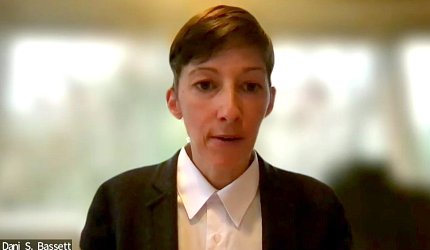Skeptical, Critical, Objective
Bassett Considers ‘Beautiful, Rational Process of Science’

In a recent Wednesday Afternoon Lecture, Dr. Dani Bassett delivered a virtual love letter to science.
“I absolutely love science,” Bassett began. “I love science for a whole bunch of reasons. I love the ends of science. I love the process of science and I love the people of science. I love the intoxicating feeling of discovery.”
The J. Peter Skirkanich professor at the University of Pennsylvania, with appointments in the departments of bioengineering, physics & astronomy, electrical & systems engineering, neurology and psychiatry, then invited fellow scientists to help improve the object of their affection.
Bassett’s lecture, “Thinking Critically About How We Do Science,” called on those intimate with the field to examine it more objectively, instead of as one might a friend—so familiar with its traditional associations and customary norms that new, diverse points of view and relationships are overlooked or discarded out of hand.
“The field of science-of-science combines information from the process of science, statistics, machine learning and big data to answer such questions as ‘How does science happen?’ ‘How are scientific questions chosen to pursue?’ ‘How do we determine where the scientific frontiers are and then step beyond them?’” Bassett explained.

“One’s floored by Dani’s profound creativity, intellectual flexibility combined with a close attention to detail and really inspirational collegiality,” said Dr. Armin Raznahan, chief of NIMH’s section on developmental neurogenomics, introducing the guest speaker. “Dani’s had an immeasurable impact on the way I do science and the way I think about being a scientist.”
Take, for example, the significance of citing other scientists’ work. Using a term coined by British Australian scholar Dr. Sara Ahmed, Bassett described journal citations as the “academic bricks” that virtually function as the “building blocks of careers” and often can also determine the direction, scope and nature of whole fields of inquiry.
Bassett shared research conducted by their group as well as other colleagues and labs. They studied hundreds of thousands of journal articles in the top journals in several fields—neuroscience, astronomy, cognitive neuroscience, medicine, physics—and found distinctive evidence of under-citation of work by women and people of color. Papers authored by white men were overcited, according to data Bassett’s team and several other teams collected from previous studies.

“Think about how we can respond as scientists, taking that wonderful scientific brain that I love in all of us and turning it toward these data,” Bassett urged.
“Let’s be skeptical, critical and objective about us...Let’s look at the fact that this is coming up in many, many different fields and it’s happening both in gender and in race and ethnicity, and let’s think hard about what that might mean.”
Citations in scientific literature aside, Bassett also raised the vast literature in gender and racial/ethnic disparities in compensation, grant funding, credit for collaborative work, teaching evaluations, hiring and promotion, productivity and authorship.
“We should look at these data and recognize that we are not some special breed of human immune to racism, sexism, classism, etc.”
One of the drivers of the imbalance, Bassett said, is simply tradition, or a “citation practice that has remained the same since 1995.” While the scientific workforce has slowly grown more diverse and inclusive in the last few decades, many scientific practices have not evolved alongside the demographics of scientific communities.
Scientists still draw frequently from mainly familiar pools of colleagues and associates when citing work.
“This is called homophily,” Bassett explained. “We end up citing people who are a lot like us. We cite people of our own gender and we cite people of our own ethnicity and race. Homophily is very prevalent in the fields I canvassed [in this lecture]…This presents a challenge to us to think differently about how we cite outside our coauthorship networks, but also to think of expanding our coauthorship networks, to be more diverse and more inclusive.”
So how can scientists help mitigate some of the drivers of inequality? Bassett offered several suggestions.
- Check and fix individual reference lists. Use readily available software and other IT tools to give papers a once-over before submitting for publication.
- Add a “citation diversity statement” to articles, reporting efforts to address citation inequality in the work, thereby raising awareness in future readers.
- Bring more inequity to light and develop additional tools to mitigate it. Only by engaging in a self-critique can the scientific enterprise also self-correct.
“If our waves of inquiry are guided into narrow branches defined by a famous thinker, a privileged gender, an advantaged race, a single ethnicity or given prestige, then what tremendous swaths of discovery are we leaving unconsidered, unexamined and unknown?” Bassett concluded. “We have an opportunity to use the beautiful rational process of science to learn more about how we structure our inquiry.”
Watch the full lecture at https://videocast.nih.gov/watch=44188.
